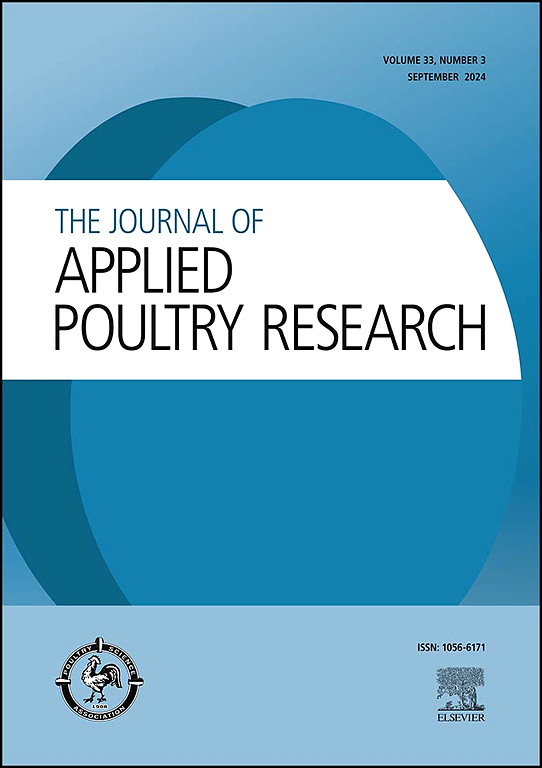Field report: mitigating ammonia emissions using a novel atomizing air cleansing technology
IF 2
3区 农林科学
Q2 AGRICULTURE, DAIRY & ANIMAL SCIENCE
引用次数: 0
Abstract
Ammonia (NH₃) odor influences growth performance and harms broilers at market age. The Atomizing Vapor Particles Air Cleansing Technology atomizes liquid into small droplets, to maximize surface area for the removal of NH₃, and can be used as an effective agricultural waste and industrial air purification system to prevent anorexia in broilers. The objectives of this research were to (1) introduce atomization as a cost-effective method for reducing NH₃ emissions, (2) evaluate NH₃ concentrations in the brooding house following atomization and acidified litter amendment treatments, targeting levels below 15 parts per million (ppm). Trial 1 evaluated the efficacy of 8 NH₃ control strategies, comparing different litter types (fresh vs. >4-year-old), litter control (atomization, citric acid with/without water, acidified litter amendment), and ventilation schedules (0-14 days no ventilation, then 30‑sec every 5 min from 15 to 48 days vs. continuous ventilation 30‑sec every 5 min from 0 to 48 days). Target NH₃ levels ranged from <15 to <35 ppm across treatments. In trial 2, eight NH₃ control strategies in combination with different NH₃ stress levels were tested. This included a clean, zero-stress, no-litter amendment control (T1), atomized vapor air NH₃ control (T2-T4), acidified litter amendments using sodium bisulfate to control for NH₃ (T5-T7), and no NH₃ control strategy on old litter. Treatment 6 represents the 2024 industry standard, which uses aggressive ventilation with sodium bisulfate litter treatment. Treatments also varied in strategies, ranging from continuous aggressive ventilation to no intervention in mild to extreme stress environments. The 1X atomization treatment of >5-year-old litter (T2) in the second trial kept NH₃ levels below 10 ppm. Combined, these findings revealed the importance of atomization in keeping NH₃ concentration low. Atomization in combination with ventilation strategies might help to optimize broiler growth while minimizing environmental stress and the negative effects of odor and anorexia on broiler chickens.
现场报告:使用新型雾化空气净化技术减少氨排放
氨气(nh3)气味影响生长性能,对市场日龄肉鸡有害。雾化蒸汽颗粒空气净化技术将液体雾化成小液滴,使NH₃的表面积最大化,可以作为有效的农业废弃物和工业空气净化系统,防止肉鸡厌食症。这项研究的目标是(1)引入雾化作为一种成本效益高的方法来减少NH₃的排放,(2)在雾化和酸化枯枝落叶处理后评估养鸡场中NH₃的浓度,目标是低于15 ppm的水平。试验1评估了8种NH₃控制策略的效果,比较了不同的凋落物类型(新鲜与4岁)、凋落物控制(雾化、柠檬酸加/不加水、酸化凋落物修改)和通风时间表(0-14天不通风,然后从15天到48天每5分钟30秒与从0天到48天每5分钟30秒连续通风)。在不同的治疗过程中,NH₃的目标水平从15 ppm到35 ppm不等。在试验2中,结合不同的NH₃压力水平,测试了8种NH₃控制策略。这包括一个干净的、零压力的、无垃圾的改进剂控制(T1),雾化蒸汽空气NH₃控制(T2-T4),使用亚硫酸氢钠来控制NH₃的酸化垃圾改进剂(T5-T7),以及对旧垃圾的无NH₃控制策略。处理6代表了2024年的行业标准,它使用了积极的通风和硫酸钠垃圾处理。治疗策略也各不相同,从持续积极通气到在轻度到极端压力环境中不进行干预。在第二次试验中,对5年生的垃圾(T2)进行1X雾化处理,使NH₃的浓度低于10ppm。综合起来,这些发现揭示了雾化在保持NH₃浓度低方面的重要性。雾化与通风策略相结合可能有助于优化肉仔鸡生长,同时最大限度地减少环境应激和气味和厌食对肉仔鸡的负面影响。
本文章由计算机程序翻译,如有差异,请以英文原文为准。
求助全文
约1分钟内获得全文
求助全文
来源期刊

Journal of Applied Poultry Research
农林科学-奶制品与动物科学
CiteScore
4.10
自引率
10.50%
发文量
80
审稿时长
104 days
期刊介绍:
The Journal of Applied Poultry Research (JAPR) publishes original research reports, field reports, and reviews on breeding, hatching, health and disease, layer management, meat bird processing and products, meat bird management, microbiology, food safety, nutrition, environment, sanitation, welfare, and economics. As of January 2020, JAPR will become an Open Access journal with no subscription charges, meaning authors who publish here can make their research immediately, permanently, and freely accessible worldwide while retaining copyright to their work. Papers submitted for publication after October 1, 2019 will be published as Open Access papers.
The readers of JAPR are in education, extension, industry, and government, including research, teaching, administration, veterinary medicine, management, production, quality assurance, product development, and technical services. Nutritionists, breeder flock supervisors, production managers, microbiologists, laboratory personnel, food safety and sanitation managers, poultry processing managers, feed manufacturers, and egg producers use JAPR to keep up with current applied poultry research.
 求助内容:
求助内容: 应助结果提醒方式:
应助结果提醒方式:


